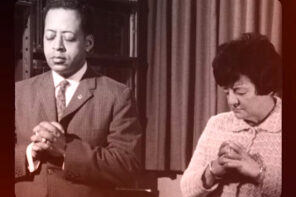Last weekend, an op-ed appeared in the New York Times entitled “How Yoga Won the West.” The author, accomplished journalist Ann Louise Bardach, suggests that the answer is simple: Swami Vivekananda, the early twentieth century sage and ambassador of Hinduism. I wasn’t surprised, since Vivekananda is often valorized as the great deliverer of yoga to “the West” or the “Father of modern yoga” in the popular press. But frankly, I’m tired of hearing it. And it’s just not true.
Bardach, who is at work on a biography of Vivekananda, doesn’t simply suggest that contemporary yogis owe the great man a big thank you for blessing them with the gift of yoga, but also criticizes those modern-day yogis for not living up to the standards of the “great seer.” She is confident that “an exercise cult with expensive accessories was hardly what he had in mind.” And, while Vivekananda was responsible for “dazzling some of the great minds of his time,” she adds, “precious few of the estimated 16 million supple, spandex-clad yoginis in the United States, who sustain an annual $6 billion industry, seem to have a clue that they owe their yoga mats to Vivekananda.”
From Noble Origins to New Age? Not So Simple
Bardach asserts that it was Vivekananda who introduced yoga into the American “national conversation.” I’m not suggesting that we ignore Vivekananda’s proven significance in the history and development of modern yoga, but the story is complicated—much more so than the simple narrative Bardach offers, namely: a great teacher introduced yoga to the West, “great minds” loved him, yoga was eventually co-opted by New Age baby boomers, and it all went downhill from there.
Before Vivekananda came to the United States with his version of yoga and gave his famous speech to the World’s Parliament of Religions in Chicago in 1893, which triggered the speaking tour that would take him all over the country, other Americans’ embrace of yoga was stirring plenty of conversation.
Consider Pierre Bernard, a turn-of-the-century American social radical, sexual deviant, and early modern yogi. Bernard discovered yoga in his boyhood when he met an Indian yogi by the name of Sylvais Hamati in Lincoln, Nebraska. Hamati became the boy’s guru, and Bernard mastered many yoga techniques under his guidance. As a young man, Bernard spent years reveling in the public spectacle of his yoga trances. He later became a fashionable businessman and community leader, but always remained a teacher of yoga.
At every stage of Bernard’s yoga career, mainstream Americans remained suspicious of his teachings. He received media attention from all over the country but only attracted a small following made up of those who could afford, both financially and socially, to be eccentric. There were numerous attempts by law enforcement, the media, and the Christian clergy to force Bernard and his students to forfeit yoga; although they successfully resisted.
Next consider the tragic case of Ida C. Craddock, another American social radical, sexual deviant (it turns out there are a lot of them in the history of yoga), and early modern yogi. Craddock, like Bernard, lived in a period characterized by various attempts to legally enforce fundamentalist interpretations of what it meant to be a “Christian nation.” Most notable of such attempts were those of U.S. Postal Inspector and founder of the New York Society for the Suppression of Vice, Anthony Comstock, who used his position in the postal service to censor whatever he deemed a threat to the evangelical Protestant Christian morals he identified as American. Unsurprisingly, Craddock’s teachings on yoga conflicted with Comstock’s ideals, so he sought to enforce legal standards that would qualify her teachings as illegal. In 1902, after being convicted for charges of obscenity, Craddock spent three torturous months in prison and, with the threat of more prison time, eventually killed herself.
Not a Fan of the Yoga Postures
So mainstream America hasn’t always been friendly toward yoga, and Vivekananda was not the sole person responsible for changing that—for making sure Americans don’t have to hide their yoga mats. Both Craddock and Bernard were Vivekananda’s contemporaries and even interacted with him, but they fought separate, unique battles to familiarize Americans with yoga.
To be clear, Vivekananda also took risks in this regard. His emphasis on self-control, meditation, and psychology appealed to many Americans who sought to counter mainstream institutional forms of religion with new metaphysical movements, such as Christian Science and New Thought. He encouraged his disciples to turn inward, toward the self, rather than outward, toward either Christian or Hindu orthodoxies. Vivekananda responded to Americans interested in wedding metaphysics with modern ideas and values as well as the aim of self-realization. In all of these ways, he appealed to an American audience made up of individuals with controversial, and sometimes esoteric, religious interests.
But Vivekananda also prescribed modern yoga in a form far less radical than those of more controversial early modern yogis, like Craddock and Bernard. Craddock and Bernard’s renditions of yoga resulted in persecution because they were interested in the body practices believed to result in more pleasurable bodily experiences. Vivekananda censored yoga of most body practices (he wasn’t a fan of yoga postures, for instance), which made it possible for him to develop a substantive following in a culture suspicious of such techniques, but his yoga was still a countercultural practice to say the least. Modern yoga had quite a long way to go before it would undergo popularization.
All this, and yet Bardach writes about Vivekananda as though he reflected something mainstream in American culture: “His prescription for life was simple, and perfectly American: ‘work and worship.’” And she claims that Vivekananda’s popularity waned because America’s “baby boomers commandeered the yoga business.”
First, Vivekananda was never “popular” in the sense that modern yoga became popularized in the late twentieth century. He certainly gained the attention of a substantive American audience, but he did not popularize himself or yoga, much less the type of yoga performed on mats across the country today. Although Bardach recognizes that Vivekananda’s version of yoga does not look like that of contemporary, popularized forms, she does not account for the fact that his version of yoga was controversial and outside the mainstream during his lifetime.
Second, the development of a form of yoga that would eventually become popularized, which didn’t happen until the late twentieth century, was made possible by nineteenth-century interactions between American and European physical culture and elite, Indian yoga culture in the context of colonialism. Those interactions resulted in the posture practice at the center of popularized forms of yoga today. So to even suggest, that yoga “won the West”—and that Vivekananda was the key player—is a gross simplification of modern yoga’s long, complex history.
So why might someone insist on simplifying the history of modern yoga? Perhaps it’s because we crave an origins myth that romanticizes the encounter between “East” and “West” and downplays the dark sides of that history. Perhaps we prefer a simple, romantic myth of a handsome Indian man delivering yoga as a gift to us rather than a complex one, tinged by colonialism, elitism, deviancy, and even death. Perhaps we rather thank Vivekananda for our yoga mats than an obscure Indian from Nebraska who we know little about and his socially radical disciple or a mystic-sexologist who committed suicide in order to escape a future in an American prison. Perhaps we prefer simpler, happier myths.
But the fact is they’re just wrong, as they ignore the power plays and persecution that affected the living bodies of yogis who, if alive today, would certainly not take the readily available mat for granted.
So no, I will not thank Vivekananda for my mat. He wouldn’t approve of what I do on it anyway.




